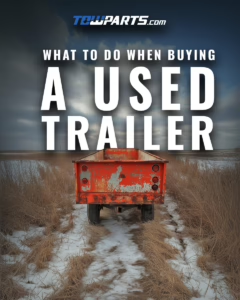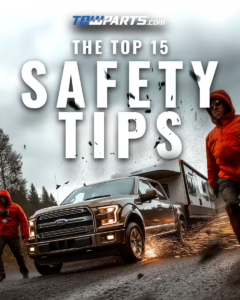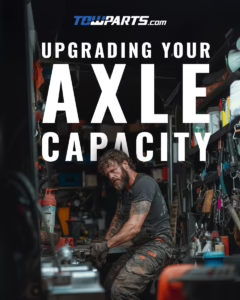
What to Look for When Buying a Used Trailer, A TowParts Trailer Parts Guide
When purchasing a used trailer, it’s essential to conduct a thorough inspection to ensure all
When it comes to towing stability, comfort, and overall safety, few factors matter more than your trailer suspension. A well-designed, properly maintained suspension system helps ensure that your trailer tows smoothly behind your vehicle, reduces sway, and prevents premature wear on essential components. Whether you’re hauling a small utility trailer or a medium-duty work rig, understanding how your trailer’s suspension works—and how to maintain or upgrade it—can make all the difference.
In this guide, we’ll break down the basics of trailer suspension, highlight the signs that it may need attention, explore common types of suspension setups, and offer tips on maintenance and upgrades. By the end, you’ll be armed with the knowledge you need to keep your trailer riding comfortably and safely for years to come.
Understanding the Basics of Trailer Suspension
Your trailer’s suspension system absorbs road shock, supports the load, and maintains proper wheel alignment. Key components often include leaf springs, equalizers, shackles, hangers, U-bolts, and related hardware. In a well-tuned system, these parts work together to ensure stable handling, minimize bouncing, and keep your cargo secure.
By selecting the right combination of these components, you ensure that your trailer can handle bumps, turns, and varying load conditions with ease.
A poorly maintained suspension can compromise safety and reduce ride quality. Be on the lookout for:
• Uneven Tire Wear: Uneven wear may indicate misalignment due to worn springs, hangers, or equalizers.
• Excessive Bouncing or Swaying: More sway in crosswinds or excessive bounce over minor bumps suggests worn or underperforming parts.
• Noisy Components: Squeaks, rattles, or groans might mean it’s time to inspect your suspension hardware for looseness or damage.
Addressing these issues early prevents more expensive damage down the road. For overall maintenance tips that complement suspension care, consider reading our other guides, such as A Guide to Trailer Axles and Avoid These Common Mistakes When Buying Trailer Parts.
Common suspension systems for light to medium-duty trailers include:
1. Leaf Spring Suspension:
The go-to choice for many trailers, leaf springs are known for durability and simplicity. They provide even weight distribution and effective shock absorption.
Browse our Leaf Springs & Suspension category to find the right springs for your trailer’s rating. For example, upgrading to a higher-capacity spring can help if you’ve increased your trailer’s cargo load.
2. Torsion Axle Suspension:
Using rubber cords inside the axle, torsion suspensions offer a smoother ride and independent wheel movement. While we focus here on leaf spring components, understanding torsion setups can help you decide if a future upgrade is right for you.
Choosing the best suspension system depends on how you use your trailer. For most owners, a leaf spring setup with the correct load rating is ideal. Consider:
• Leaf Springs: Ensure springs match your trailer’s axle capacity.
• U-Bolt Kits: Secure springs and axles with the right U-Bolt Kits to ensure everything stays in place during travel.
If you’re unsure what ratings or bolt patterns to choose, our other resources can help. Browse posts like Trailer Parts Online or Hauling a Trailer Better to gain more insight into proper trailer setup and maintenance.
Regular maintenance keeps your trailer suspension in top shape:
1. Routine Inspections:
Periodically inspect springs, shackles, hangers, and U-bolts for signs of wear, rust, or cracks. Replace damaged parts promptly.
2. Lubrication:
Grease moving parts according to manufacturer guidelines. Proper lubrication reduces friction, extending the life of your suspension hardware.
3. Torque Specs:
Confirm that all bolts and fasteners are tightened to the recommended torque. Properly torqued hardware ensures stability and prevents parts from loosening over time.
4. Adjustments & Upgrades:
If you frequently travel on rough roads or carry heavy loads, consider heavier-duty leaf springs or upgrading your equalizers. Refer to Upgrading Your Axle Capacity for tips on ensuring all components, including suspension, match your new load requirements.
High-quality suspension parts are vital for longevity and safety. At TowParts.com, we source components that meet or exceed industry standards. Many parts align with certifications like:
• CSA (Canadian Standards Association): www.csagroup.org
• SAE (Society of Automotive Engineers): www.sae.org
• QAI (Quality Auditing Institute): www.qai.org
Choosing certified components gives you peace of mind, knowing your trailer is equipped with parts that have undergone rigorous testing for durability and performance.
Maintaining your trailer suspension is one part of keeping it road-ready. For more comprehensive care, check out our other guides:
• A Guide to Trailer Axles: Maintenance, Upgrades, and Everything Great You Need to Know
• Upgrading Your Axle Capacity
• Avoid These Common Mistakes When Buying Trailer Parts
These resources complement your knowledge of trailer suspension and help you maintain every aspect of your setup.
Conclusion
Your trailer suspension is crucial to ensuring a smooth, stable, and safe towing experience. By understanding the basics, recognizing signs of wear, choosing the right components.
Invest in certified, high-quality components from TowParts.com to ensure longevity, performance, and peace of mind. With the right combination of informed care and reliable parts, you’ll enjoy a trailer that handles beautifully, providing safer travels and protecting your valuable cargo.


When purchasing a used trailer, it’s essential to conduct a thorough inspection to ensure all

Your trailer’s performance, safety, and longevity depend on high-quality trailer axles. Understanding their purpose, recognizing

When you rely on your trailer—whether it’s for work, travel, or recreation—you need to know

Title: The Top 15 Safety Tips for Towing a Trailer Towing a trailer is a

Thinking of upgrading your trailer’s axle capacity? Learn what to consider first—from ensuring frame integrity

One of the first big decisions you’ll face as a trailer hauler is choosing between